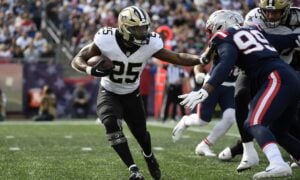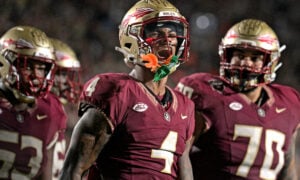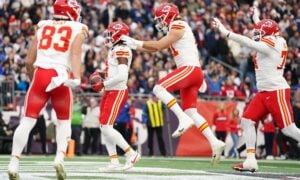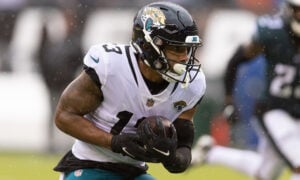2015 Market Share Report
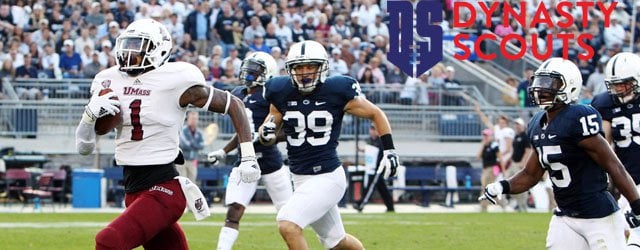
Some people fail at meeting their goals because they neglect the tools they have at their disposal. For instance, try reading a book without turning the light on. You are going to fail when the room gets dark. Catch my drift? Metrics and key performance indicators are essential tools when forecasting future fantasy production of players. If certain data points are ignored then there’s a risk that a future fantasy asset could be over looked causing the player to fall into the hands of the opposition.
Market share data analysis is a very important measurement of a player’s production. It is the percentage of production that a player owns within their offense. For example, Player X produced 30.12 percent of his team’s offense. A wide receiver’s market share data is configured of the percentage that they own with in the passing offense. The reason being, is typically wide receivers are not apart of the run game.
There are different types of offensive systems in college football that affects player’s production. A player’s statistics could be inflated due to sheer offensive volume. Market share data curtails the effects of the player’s offensive scheme by displaying the importance of a player’s role within the offense from a production standpoint.
Players who are productive but have missed games due to injury or suspensions typically have a lower share of the offense due to the games missed. Keep that in mind when sorting through the data. Be aware of the small school players because their production is obtained by playing against lesser competition.
This is a good tool when used in conjunction with watching tape and analyzing athletic metrics. It makes it easy to quickly examine the player’s production while breaking down all aspects of the player’s profile.
The tables below are ranking the wide receivers by class. This gives us an educated guess of the players age combined with their most recent production because birth dates for a lot of college prospects are almost impossible to obtain, especially for freshmen and sophomores.
[am4show have=’g1;’ guest_error=’sub_message’ user_error=’sub_message’ ]
Any receiver who caught 600 yards or more during the 2015 season was pulled for this study and the players who had a 25 percent market share or higher was used in the tables below. The sample size for freshman was very low, so I used all the players that qualified in their table.

Tajae Sharpe, WR Massachusetts
The first thing that pops off the table is that Sharpe owns 42.69 percent of his team’s market share in the passing game, which is insanely high. The numbers indicate that there could be something special about him and we should watch extra film on him to appropriately evaluate him.
Aaron Burbridge, WR Michigan State
I like Burbridge, I thought he played very well this season and I’m not surprised about his production. He’s clutch, he was always bailing out Connor Cook with spectacular catches late in games.
Leonte Caroo, WR Rutgers
A lot of people love Caroo. I can’t blame them because he’s good. His 32.56 market share percentage is outstanding, considering that he missed four games last season. He has the ability to take over games. He played in four games last season where he caught at least 120 yards or more.
Sterling Shepard, WR Oklahoma
Shepard is another popular prospect and he is projected to be a first-round pick in rookie drafts. He was hyper productive last season catching 87 receptions for 1,288 yards and 11 touchdowns.
Josh Doctson, WR TCU
Don’t be alarmed at Doctson’s 29.38 market share because it’s still very good, not to mention that he missed three games last season, which caused a deflation in his statistical output.
Michael Thomas, WR Southern Mississippi
He is a player that could rise on some people’s draft boards during the next few months and his market share within the offense is one of the reasons why his draft value could escalate.

Corey Davis, WR Western Michigan
I think Davis is making a mistake by not coming out for this year’s draft. His stock can’t get any higher and he would have been one of the top wide receivers in this year’s draft. Having a 38.48 percent market share is phenomenal and shows that he has the potential to become a dynamic asset.
Tyler Boyd, WR Pittsburgh
Boyd is a hot name going into this year’s draft. He’s going to be a potential first round pick and a top three pick in rookie drafts. His 37.37 market share percentage is a good indicator of why he’s deserving of those accolades.
Pharoh Cooper, WR South Carolina
Cooper’s numbers were surprising, he’s a player that could fall into the second round of rookie drafts and could potentially become a steal. He’s very quick and he’s dangerous with the ball in space.
Will Fuller, WR Notre Dame
Mel Kiper currently has him selected in the first round of his most recent mock draft. During his last two seasons at Notre Dame he caught 138 receptions for 2,348 yards and 29 touchdowns.
Rashard Higgins, WR Colorado State
Higgins had a down year compared to the production he displayed during his sophomore season, but he still managed to capture a large portion of his team’s offensive production. Colorado State went from averaging 321 passing yards per game in 2014 to averaging just 228 passing yards per game. The decrease in the team’s offensive volume was a major factor to the drop-off to his end of year statistics.
Laquon Treadwell, WR Ole Miss
His production seems low compared to the other receivers listed but 26.50 percent isn’t a bad market share. Remember, he was coming back from a nasty leg injury that he suffered during his sophomore season and the team eased him back into the offense during the beginning of last year.
Michael Thomas, WR Ohio State
Thomas is one of my favorite receivers in football, I like his size and his ability to run routes. Even though, he only caught 781 yards, he still owned a very large portion of the pie in Ohio State’s passing offense.
Josh Reynolds, WR Texas A&M
He’s returning to school for next season. He’s a tall thin receiver standing at 6-foot-4 and 190 pounds. He’s very good at out leaping defenders to make contested catches.
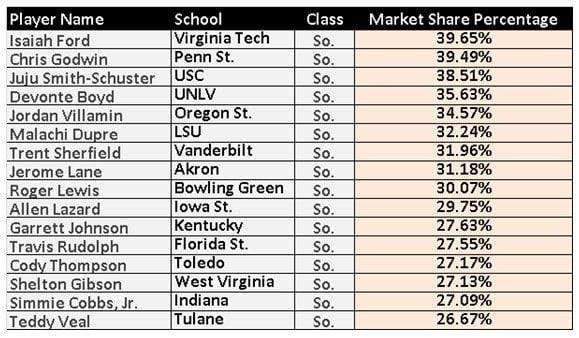
The list for sophomores is a lot smaller compared to the juniors and seniors. It’s harder for younger prospects for take over their offense’s production and players typically don’t become key contributors until their junior season. Players who break out during their freshman and sophomore are more likely to become premier NFL draft prospects.
Chris Godwin, WR Penn State
I watched a lot of Penn State games and Godwin stood out to me during every single one of them. He has good hands and he’s very good at separating from defenders. He finished the season second in the Big Ten in receiving.
Juju Smith-Schuster, WR USC
He is a stud prospect and could be the top pick in rookie drafts next season. For me, he has just about everything you want in a wide receiver.
Malachi Dupre, WR LSU
His market share figures isn’t a surprise. He’s one of the top receivers in college and he’s going to be a hot commodity in rookie drafts next season.
Simmie Cobbs Jr., WR Indiana
He is clutch and could be a dark horse. He’s a really interesting prospect when you combine his size, 6-4 and 212 pounds, and his current production.
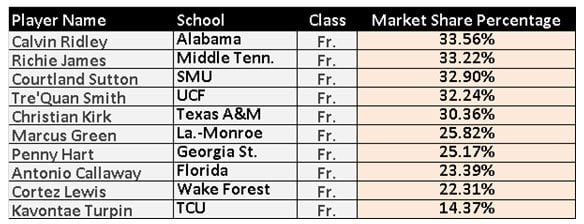
It’s hard for freshman players to get opportunities within their offense. Usually, it’s an indication that the player could develop into a special prospect when the player can take over a large portion of their offense’s production during their freshman season.
Calvin Ridley, WR Alabama
Ridley has special written all over him. He is very polished for a freshman wide receiver. He was unstoppable against Michigan State in the Cotton Bowl by catching eight receptions for 138 yards and two touchdowns.
Antonio Callaway, WR Florida
He was a four-star recruit coming out of high school and could be an intriguing prospect in the future.
Christian Kirk, WR Texas A&M
He’s very quick and he’s good at separating from defenders. He was a five-star recruit coming out of high school and he produced right away in college, catching 80 receptions for 1,009 yards and seven touchdowns.
As you can see the market share data is a very good tool to help you make your evaluations on prospects. It’s not the end-all, be-all, you still need to study tape and pay attention to athletic metrics to get a grasp on the players potential. A player can check every box and still become a bust. Doing the work by studying the numbers and watching tape will increase your hit rate on your rookie and devy draft picks.
[/am4show]






